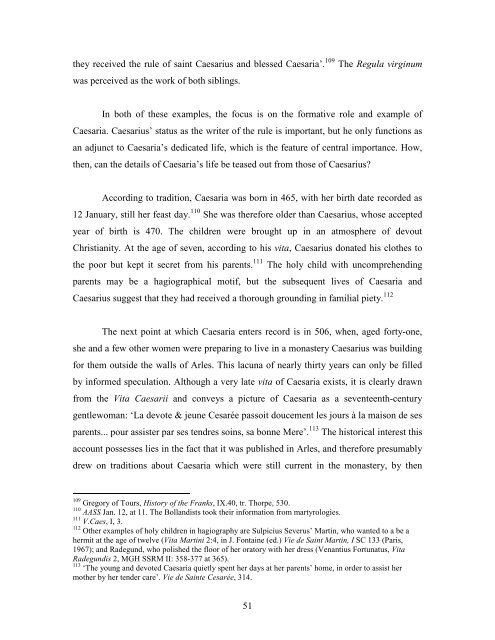Lindsay Rudge PhD Thesis - University of St Andrews
Lindsay Rudge PhD Thesis - University of St Andrews
Lindsay Rudge PhD Thesis - University of St Andrews
You also want an ePaper? Increase the reach of your titles
YUMPU automatically turns print PDFs into web optimized ePapers that Google loves.
they received the rule <strong>of</strong> saint Caesarius and blessed Caesaria’. 109 The Regula virginum<br />
was perceived as the work <strong>of</strong> both siblings.<br />
In both <strong>of</strong> these examples, the focus is on the formative role and example <strong>of</strong><br />
Caesaria. Caesarius’ status as the writer <strong>of</strong> the rule is important, but he only functions as<br />
an adjunct to Caesaria’s dedicated life, which is the feature <strong>of</strong> central importance. How,<br />
then, can the details <strong>of</strong> Caesaria’s life be teased out from those <strong>of</strong> Caesarius?<br />
According to tradition, Caesaria was born in 465, with her birth date recorded as<br />
12 January, still her feast day. 110 She was therefore older than Caesarius, whose accepted<br />
year <strong>of</strong> birth is 470. The children were brought up in an atmosphere <strong>of</strong> devout<br />
Christianity. At the age <strong>of</strong> seven, according to his vita, Caesarius donated his clothes to<br />
the poor but kept it secret from his parents. 111 The holy child with uncomprehending<br />
parents may be a hagiographical motif, but the subsequent lives <strong>of</strong> Caesaria and<br />
Caesarius suggest that they had received a thorough grounding in familial piety. 112<br />
The next point at which Caesaria enters record is in 506, when, aged forty-one,<br />
she and a few other women were preparing to live in a monastery Caesarius was building<br />
for them outside the walls <strong>of</strong> Arles. This lacuna <strong>of</strong> nearly thirty years can only be filled<br />
by informed speculation. Although a very late vita <strong>of</strong> Caesaria exists, it is clearly drawn<br />
from the Vita Caesarii and conveys a picture <strong>of</strong> Caesaria as a seventeenth-century<br />
gentlewoman: ‘La devote & jeune Cesarée passoit doucement les jours à la maison de ses<br />
parents... pour assister par ses tendres soins, sa bonne Mere’. 113 The historical interest this<br />
account possesses lies in the fact that it was published in Arles, and therefore presumably<br />
drew on traditions about Caesaria which were still current in the monastery, by then<br />
109<br />
Gregory <strong>of</strong> Tours, History <strong>of</strong> the Franks, IX.40, tr. Thorpe, 530.<br />
110<br />
AASS Jan. 12, at 11. The Bollandists took their information from martyrologies.<br />
111<br />
V.Caes, I, 3.<br />
112<br />
Other examples <strong>of</strong> holy children in hagiography are Sulpicius Severus’ Martin, who wanted to a be a<br />
hermit at the age <strong>of</strong> twelve (Vita Martini 2:4, in J. Fontaine (ed.) Vie de Saint Martin, I SC 133 (Paris,<br />
1967); and Radegund, who polished the floor <strong>of</strong> her oratory with her dress (Venantius Fortunatus, Vita<br />
Radegundis 2, MGH SSRM II: 358-377 at 365).<br />
113<br />
‘The young and devoted Caesaria quietly spent her days at her parents’ home, in order to assist her<br />
mother by her tender care’. Vie de Sainte Cesarée, 314.<br />
51

















